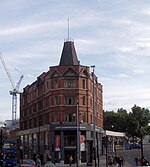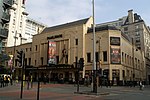Artisan Heights
2020 establishments in EnglandBuildings and structures in ManchesterGreater Manchester building and structure stubsResidential buildings completed in 2020Residential buildings in Manchester ... and 1 more
Use British English from March 2023

Artisan Heights, also known as 1-5 Wakefield Street, is a student accommodation high-rise tower in Manchester, England. The 95 m (312 ft) tall building was designed by SimpsonHaugh & Partners and contains 603 student bedrooms. As of 2023, it is the 17th-tallest building in Greater Manchester. The tower sits close to Oxford Road station and the Liberty Heights building, another high-rise student accommodation block.
Excerpt from the Wikipedia article Artisan Heights (License: CC BY-SA 3.0, Authors, Images).Artisan Heights
Great Marlborough Street, Manchester City Centre
Geographical coordinates (GPS) Address Nearby Places Show on map
Geographical coordinates (GPS)
| Latitude | Longitude |
|---|---|
| N 53.473 ° | E -2.241 ° |
Address
Great Marlborough Street
M1 5NN Manchester, City Centre
England, United Kingdom
Open on Google Maps










